Applying Crisis Management Concepts: The Samsung Galaxy Note 7 Crisis
VerifiedAdded on 2023/06/05
|19
|5074
|400
Case Study
AI Summary
This case study examines Samsung's Galaxy Note 7 crisis, highlighting the importance of effective crisis management in international business. It analyzes Samsung's response to the Note 7 explosions, concluding that inadequate crisis management contributed to the product's failure and its short market lifespan. The study applies a crisis management framework to dissect the pre-crisis context, the crisis point (battery explosions), the crisis response (recalls and replacements), and the potential impacts, offering recommendations and lessons learned. It contrasts identification and resolution stages within crisis management cycles and emphasizes the necessity of proactive risk management to transform potential risks into advantages and build investor trust. This document is available on Desklib, a platform offering AI-based study tools and a repository of student-contributed assignments and past papers.
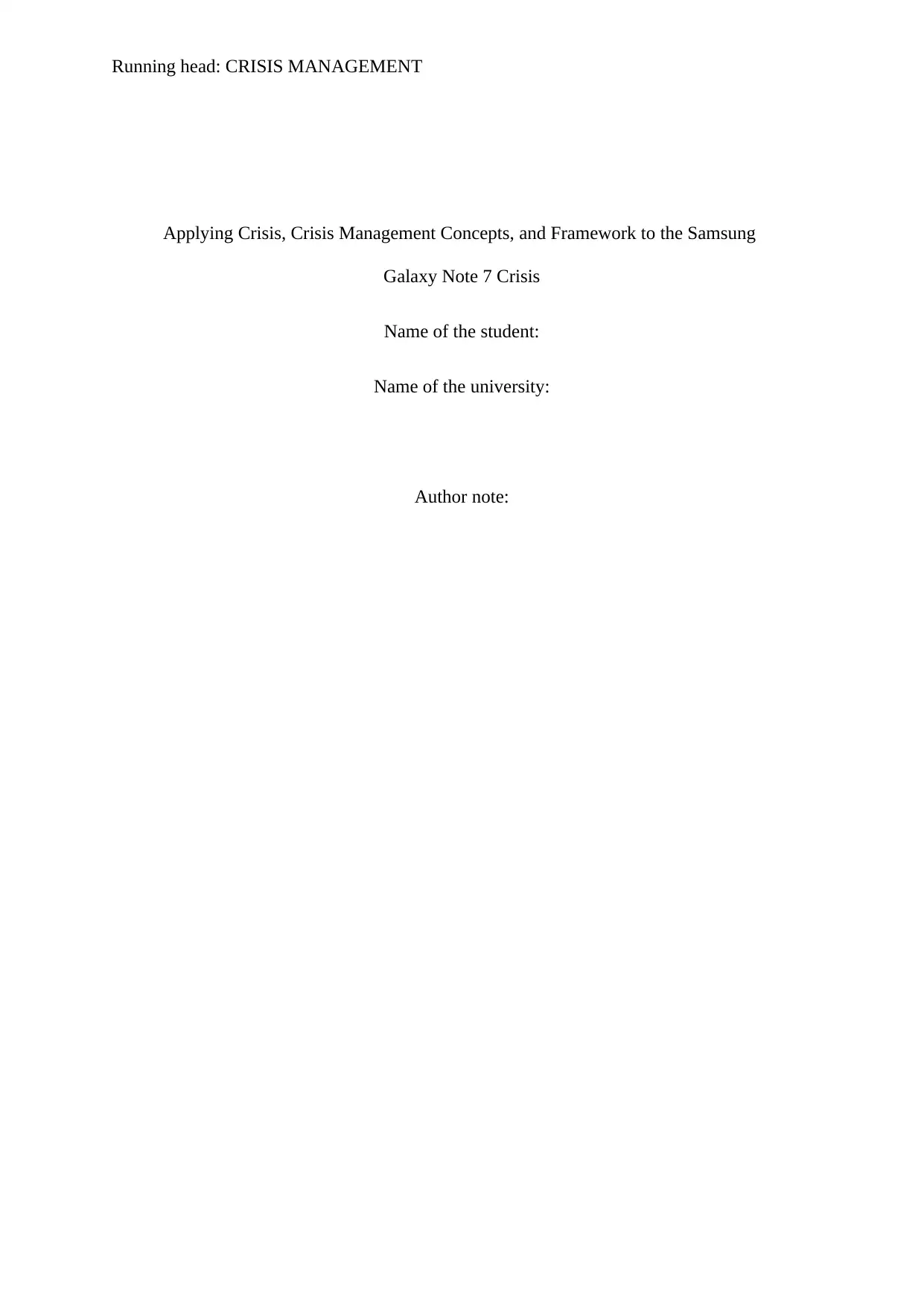
Running head: CRISIS MANAGEMENT
Applying Crisis, Crisis Management Concepts, and Framework to the Samsung
Galaxy Note 7 Crisis
Name of the student:
Name of the university:
Author note:
Applying Crisis, Crisis Management Concepts, and Framework to the Samsung
Galaxy Note 7 Crisis
Name of the student:
Name of the university:
Author note:
Paraphrase This Document
Need a fresh take? Get an instant paraphrase of this document with our AI Paraphraser
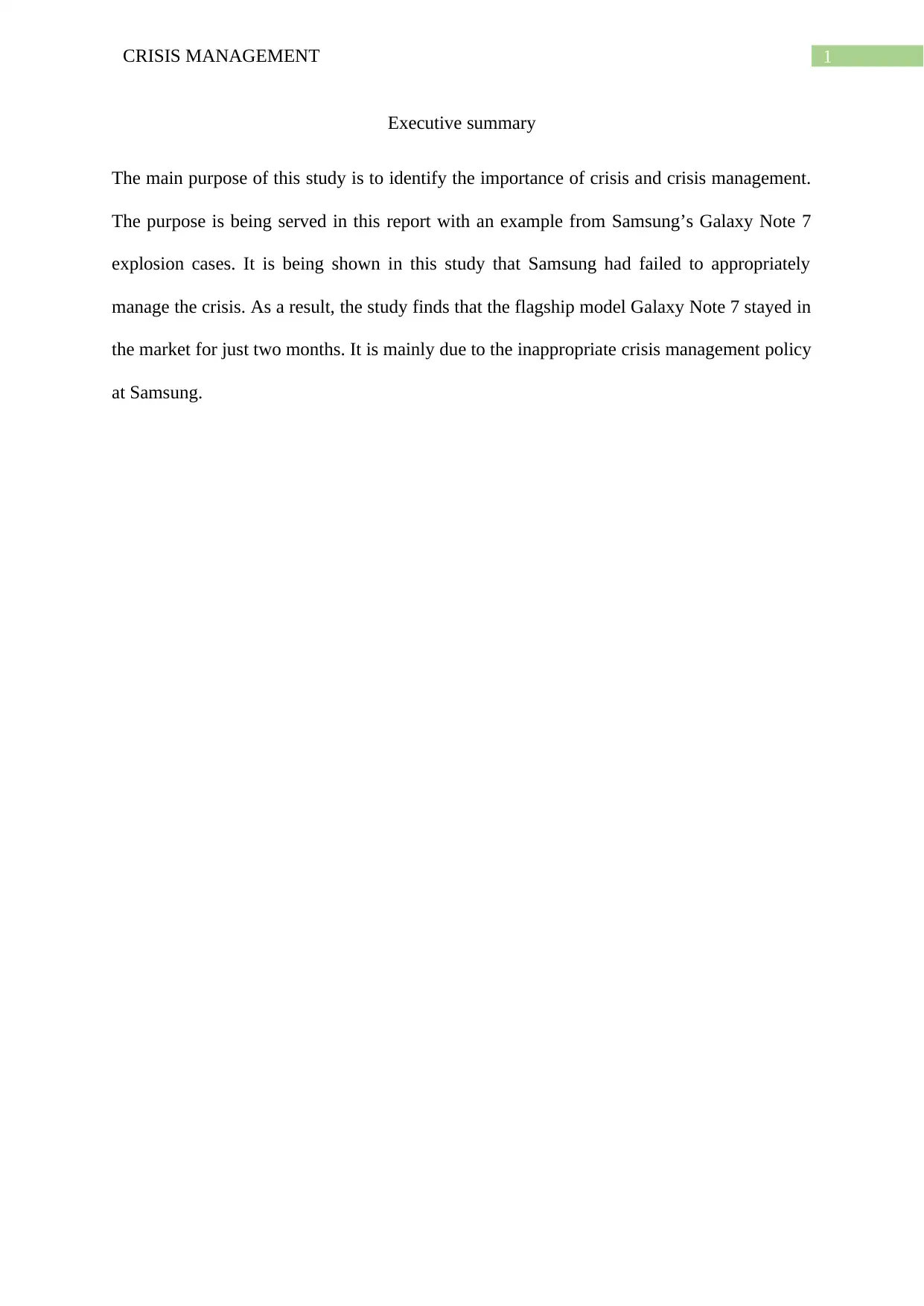
1CRISIS MANAGEMENT
Executive summary
The main purpose of this study is to identify the importance of crisis and crisis management.
The purpose is being served in this report with an example from Samsung’s Galaxy Note 7
explosion cases. It is being shown in this study that Samsung had failed to appropriately
manage the crisis. As a result, the study finds that the flagship model Galaxy Note 7 stayed in
the market for just two months. It is mainly due to the inappropriate crisis management policy
at Samsung.
Executive summary
The main purpose of this study is to identify the importance of crisis and crisis management.
The purpose is being served in this report with an example from Samsung’s Galaxy Note 7
explosion cases. It is being shown in this study that Samsung had failed to appropriately
manage the crisis. As a result, the study finds that the flagship model Galaxy Note 7 stayed in
the market for just two months. It is mainly due to the inappropriate crisis management policy
at Samsung.
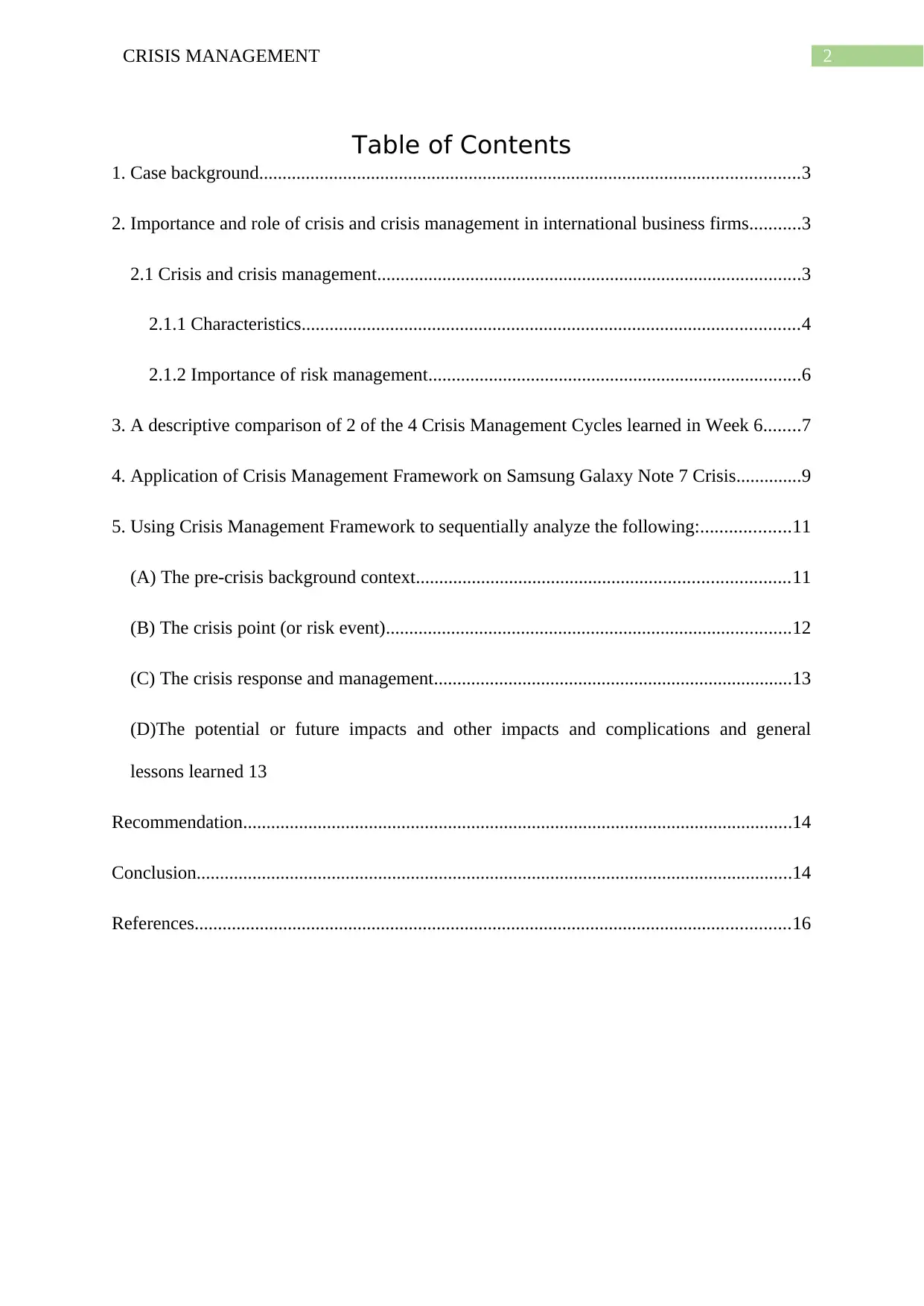
2CRISIS MANAGEMENT
Table of Contents
1. Case background....................................................................................................................3
2. Importance and role of crisis and crisis management in international business firms...........3
2.1 Crisis and crisis management...........................................................................................3
2.1.1 Characteristics...........................................................................................................4
2.1.2 Importance of risk management................................................................................6
3. A descriptive comparison of 2 of the 4 Crisis Management Cycles learned in Week 6........7
4. Application of Crisis Management Framework on Samsung Galaxy Note 7 Crisis..............9
5. Using Crisis Management Framework to sequentially analyze the following:...................11
(A) The pre-crisis background context................................................................................11
(B) The crisis point (or risk event).......................................................................................12
(C) The crisis response and management.............................................................................13
(D)The potential or future impacts and other impacts and complications and general
lessons learned 13
Recommendation......................................................................................................................14
Conclusion................................................................................................................................14
References................................................................................................................................16
Table of Contents
1. Case background....................................................................................................................3
2. Importance and role of crisis and crisis management in international business firms...........3
2.1 Crisis and crisis management...........................................................................................3
2.1.1 Characteristics...........................................................................................................4
2.1.2 Importance of risk management................................................................................6
3. A descriptive comparison of 2 of the 4 Crisis Management Cycles learned in Week 6........7
4. Application of Crisis Management Framework on Samsung Galaxy Note 7 Crisis..............9
5. Using Crisis Management Framework to sequentially analyze the following:...................11
(A) The pre-crisis background context................................................................................11
(B) The crisis point (or risk event).......................................................................................12
(C) The crisis response and management.............................................................................13
(D)The potential or future impacts and other impacts and complications and general
lessons learned 13
Recommendation......................................................................................................................14
Conclusion................................................................................................................................14
References................................................................................................................................16
⊘ This is a preview!⊘
Do you want full access?
Subscribe today to unlock all pages.

Trusted by 1+ million students worldwide
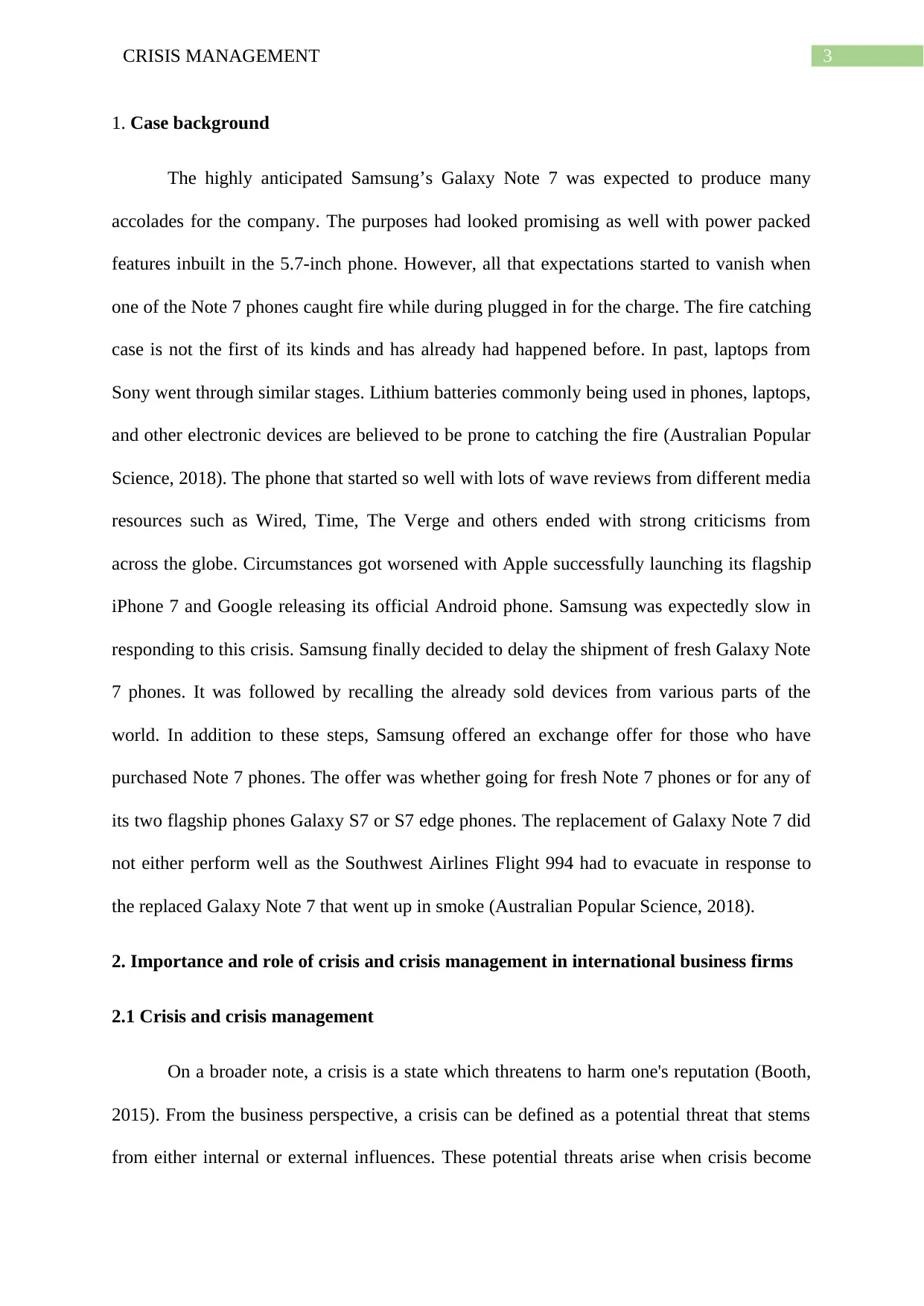
3CRISIS MANAGEMENT
1. Case background
The highly anticipated Samsung’s Galaxy Note 7 was expected to produce many
accolades for the company. The purposes had looked promising as well with power packed
features inbuilt in the 5.7-inch phone. However, all that expectations started to vanish when
one of the Note 7 phones caught fire while during plugged in for the charge. The fire catching
case is not the first of its kinds and has already had happened before. In past, laptops from
Sony went through similar stages. Lithium batteries commonly being used in phones, laptops,
and other electronic devices are believed to be prone to catching the fire (Australian Popular
Science, 2018). The phone that started so well with lots of wave reviews from different media
resources such as Wired, Time, The Verge and others ended with strong criticisms from
across the globe. Circumstances got worsened with Apple successfully launching its flagship
iPhone 7 and Google releasing its official Android phone. Samsung was expectedly slow in
responding to this crisis. Samsung finally decided to delay the shipment of fresh Galaxy Note
7 phones. It was followed by recalling the already sold devices from various parts of the
world. In addition to these steps, Samsung offered an exchange offer for those who have
purchased Note 7 phones. The offer was whether going for fresh Note 7 phones or for any of
its two flagship phones Galaxy S7 or S7 edge phones. The replacement of Galaxy Note 7 did
not either perform well as the Southwest Airlines Flight 994 had to evacuate in response to
the replaced Galaxy Note 7 that went up in smoke (Australian Popular Science, 2018).
2. Importance and role of crisis and crisis management in international business firms
2.1 Crisis and crisis management
On a broader note, a crisis is a state which threatens to harm one's reputation (Booth,
2015). From the business perspective, a crisis can be defined as a potential threat that stems
from either internal or external influences. These potential threats arise when crisis become
1. Case background
The highly anticipated Samsung’s Galaxy Note 7 was expected to produce many
accolades for the company. The purposes had looked promising as well with power packed
features inbuilt in the 5.7-inch phone. However, all that expectations started to vanish when
one of the Note 7 phones caught fire while during plugged in for the charge. The fire catching
case is not the first of its kinds and has already had happened before. In past, laptops from
Sony went through similar stages. Lithium batteries commonly being used in phones, laptops,
and other electronic devices are believed to be prone to catching the fire (Australian Popular
Science, 2018). The phone that started so well with lots of wave reviews from different media
resources such as Wired, Time, The Verge and others ended with strong criticisms from
across the globe. Circumstances got worsened with Apple successfully launching its flagship
iPhone 7 and Google releasing its official Android phone. Samsung was expectedly slow in
responding to this crisis. Samsung finally decided to delay the shipment of fresh Galaxy Note
7 phones. It was followed by recalling the already sold devices from various parts of the
world. In addition to these steps, Samsung offered an exchange offer for those who have
purchased Note 7 phones. The offer was whether going for fresh Note 7 phones or for any of
its two flagship phones Galaxy S7 or S7 edge phones. The replacement of Galaxy Note 7 did
not either perform well as the Southwest Airlines Flight 994 had to evacuate in response to
the replaced Galaxy Note 7 that went up in smoke (Australian Popular Science, 2018).
2. Importance and role of crisis and crisis management in international business firms
2.1 Crisis and crisis management
On a broader note, a crisis is a state which threatens to harm one's reputation (Booth,
2015). From the business perspective, a crisis can be defined as a potential threat that stems
from either internal or external influences. These potential threats arise when crisis become
Paraphrase This Document
Need a fresh take? Get an instant paraphrase of this document with our AI Paraphraser
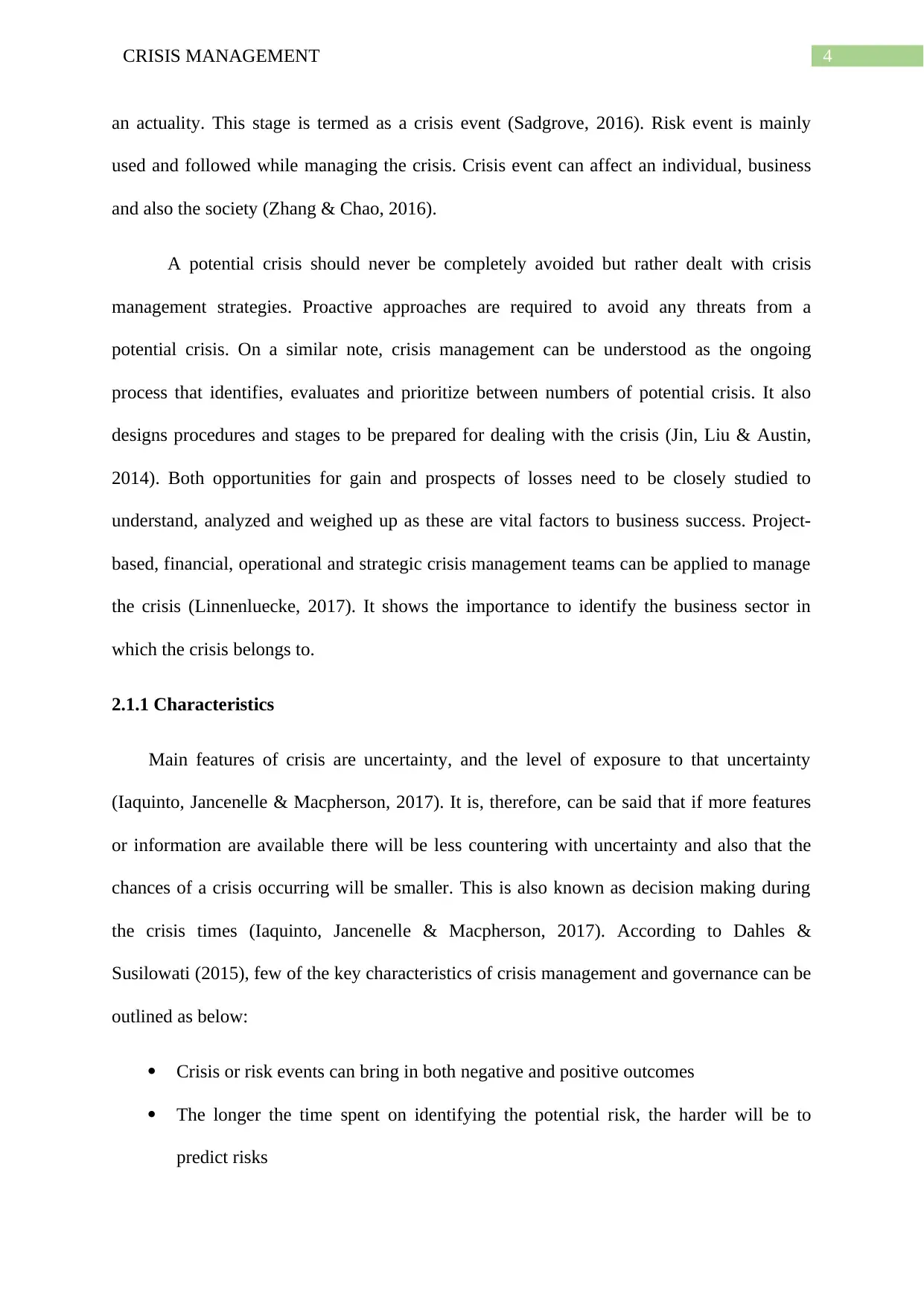
4CRISIS MANAGEMENT
an actuality. This stage is termed as a crisis event (Sadgrove, 2016). Risk event is mainly
used and followed while managing the crisis. Crisis event can affect an individual, business
and also the society (Zhang & Chao, 2016).
A potential crisis should never be completely avoided but rather dealt with crisis
management strategies. Proactive approaches are required to avoid any threats from a
potential crisis. On a similar note, crisis management can be understood as the ongoing
process that identifies, evaluates and prioritize between numbers of potential crisis. It also
designs procedures and stages to be prepared for dealing with the crisis (Jin, Liu & Austin,
2014). Both opportunities for gain and prospects of losses need to be closely studied to
understand, analyzed and weighed up as these are vital factors to business success. Project-
based, financial, operational and strategic crisis management teams can be applied to manage
the crisis (Linnenluecke, 2017). It shows the importance to identify the business sector in
which the crisis belongs to.
2.1.1 Characteristics
Main features of crisis are uncertainty, and the level of exposure to that uncertainty
(Iaquinto, Jancenelle & Macpherson, 2017). It is, therefore, can be said that if more features
or information are available there will be less countering with uncertainty and also that the
chances of a crisis occurring will be smaller. This is also known as decision making during
the crisis times (Iaquinto, Jancenelle & Macpherson, 2017). According to Dahles &
Susilowati (2015), few of the key characteristics of crisis management and governance can be
outlined as below:
Crisis or risk events can bring in both negative and positive outcomes
The longer the time spent on identifying the potential risk, the harder will be to
predict risks
an actuality. This stage is termed as a crisis event (Sadgrove, 2016). Risk event is mainly
used and followed while managing the crisis. Crisis event can affect an individual, business
and also the society (Zhang & Chao, 2016).
A potential crisis should never be completely avoided but rather dealt with crisis
management strategies. Proactive approaches are required to avoid any threats from a
potential crisis. On a similar note, crisis management can be understood as the ongoing
process that identifies, evaluates and prioritize between numbers of potential crisis. It also
designs procedures and stages to be prepared for dealing with the crisis (Jin, Liu & Austin,
2014). Both opportunities for gain and prospects of losses need to be closely studied to
understand, analyzed and weighed up as these are vital factors to business success. Project-
based, financial, operational and strategic crisis management teams can be applied to manage
the crisis (Linnenluecke, 2017). It shows the importance to identify the business sector in
which the crisis belongs to.
2.1.1 Characteristics
Main features of crisis are uncertainty, and the level of exposure to that uncertainty
(Iaquinto, Jancenelle & Macpherson, 2017). It is, therefore, can be said that if more features
or information are available there will be less countering with uncertainty and also that the
chances of a crisis occurring will be smaller. This is also known as decision making during
the crisis times (Iaquinto, Jancenelle & Macpherson, 2017). According to Dahles &
Susilowati (2015), few of the key characteristics of crisis management and governance can be
outlined as below:
Crisis or risk events can bring in both negative and positive outcomes
The longer the time spent on identifying the potential risk, the harder will be to
predict risks
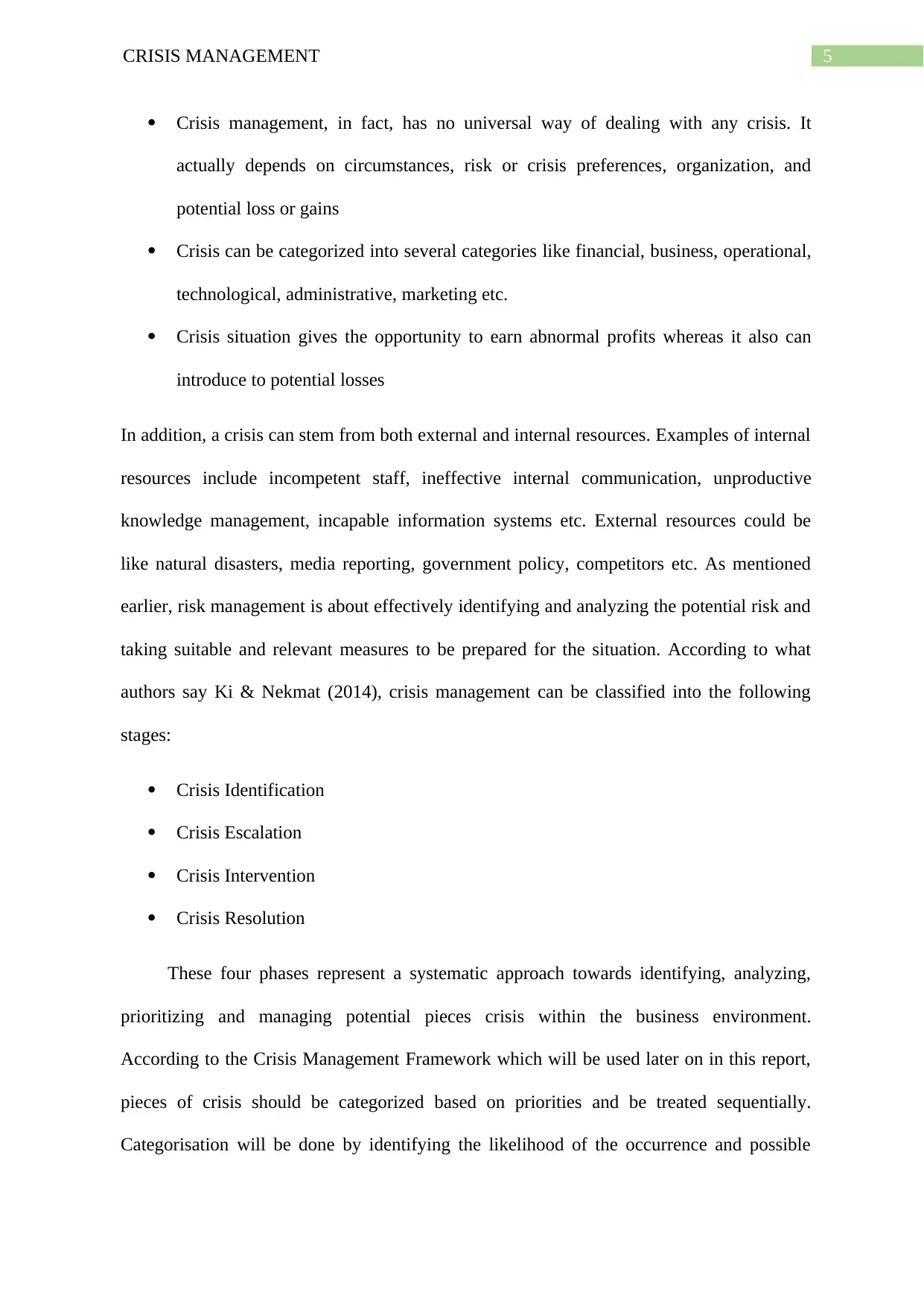
5CRISIS MANAGEMENT
Crisis management, in fact, has no universal way of dealing with any crisis. It
actually depends on circumstances, risk or crisis preferences, organization, and
potential loss or gains
Crisis can be categorized into several categories like financial, business, operational,
technological, administrative, marketing etc.
Crisis situation gives the opportunity to earn abnormal profits whereas it also can
introduce to potential losses
In addition, a crisis can stem from both external and internal resources. Examples of internal
resources include incompetent staff, ineffective internal communication, unproductive
knowledge management, incapable information systems etc. External resources could be
like natural disasters, media reporting, government policy, competitors etc. As mentioned
earlier, risk management is about effectively identifying and analyzing the potential risk and
taking suitable and relevant measures to be prepared for the situation. According to what
authors say Ki & Nekmat (2014), crisis management can be classified into the following
stages:
Crisis Identification
Crisis Escalation
Crisis Intervention
Crisis Resolution
These four phases represent a systematic approach towards identifying, analyzing,
prioritizing and managing potential pieces crisis within the business environment.
According to the Crisis Management Framework which will be used later on in this report,
pieces of crisis should be categorized based on priorities and be treated sequentially.
Categorisation will be done by identifying the likelihood of the occurrence and possible
Crisis management, in fact, has no universal way of dealing with any crisis. It
actually depends on circumstances, risk or crisis preferences, organization, and
potential loss or gains
Crisis can be categorized into several categories like financial, business, operational,
technological, administrative, marketing etc.
Crisis situation gives the opportunity to earn abnormal profits whereas it also can
introduce to potential losses
In addition, a crisis can stem from both external and internal resources. Examples of internal
resources include incompetent staff, ineffective internal communication, unproductive
knowledge management, incapable information systems etc. External resources could be
like natural disasters, media reporting, government policy, competitors etc. As mentioned
earlier, risk management is about effectively identifying and analyzing the potential risk and
taking suitable and relevant measures to be prepared for the situation. According to what
authors say Ki & Nekmat (2014), crisis management can be classified into the following
stages:
Crisis Identification
Crisis Escalation
Crisis Intervention
Crisis Resolution
These four phases represent a systematic approach towards identifying, analyzing,
prioritizing and managing potential pieces crisis within the business environment.
According to the Crisis Management Framework which will be used later on in this report,
pieces of crisis should be categorized based on priorities and be treated sequentially.
Categorisation will be done by identifying the likelihood of the occurrence and possible
⊘ This is a preview!⊘
Do you want full access?
Subscribe today to unlock all pages.

Trusted by 1+ million students worldwide
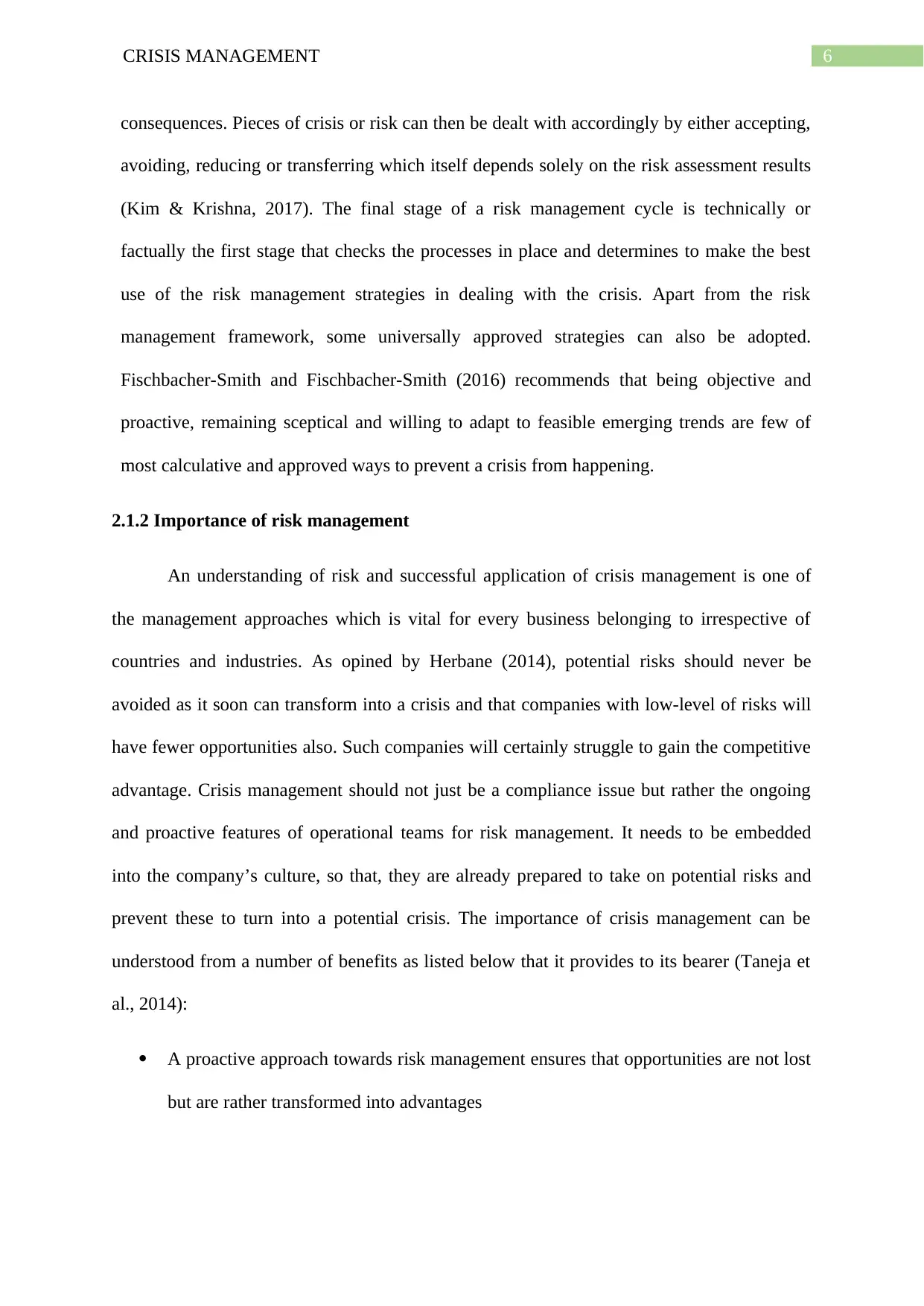
6CRISIS MANAGEMENT
consequences. Pieces of crisis or risk can then be dealt with accordingly by either accepting,
avoiding, reducing or transferring which itself depends solely on the risk assessment results
(Kim & Krishna, 2017). The final stage of a risk management cycle is technically or
factually the first stage that checks the processes in place and determines to make the best
use of the risk management strategies in dealing with the crisis. Apart from the risk
management framework, some universally approved strategies can also be adopted.
Fischbacher-Smith and Fischbacher-Smith (2016) recommends that being objective and
proactive, remaining sceptical and willing to adapt to feasible emerging trends are few of
most calculative and approved ways to prevent a crisis from happening.
2.1.2 Importance of risk management
An understanding of risk and successful application of crisis management is one of
the management approaches which is vital for every business belonging to irrespective of
countries and industries. As opined by Herbane (2014), potential risks should never be
avoided as it soon can transform into a crisis and that companies with low-level of risks will
have fewer opportunities also. Such companies will certainly struggle to gain the competitive
advantage. Crisis management should not just be a compliance issue but rather the ongoing
and proactive features of operational teams for risk management. It needs to be embedded
into the company’s culture, so that, they are already prepared to take on potential risks and
prevent these to turn into a potential crisis. The importance of crisis management can be
understood from a number of benefits as listed below that it provides to its bearer (Taneja et
al., 2014):
A proactive approach towards risk management ensures that opportunities are not lost
but are rather transformed into advantages
consequences. Pieces of crisis or risk can then be dealt with accordingly by either accepting,
avoiding, reducing or transferring which itself depends solely on the risk assessment results
(Kim & Krishna, 2017). The final stage of a risk management cycle is technically or
factually the first stage that checks the processes in place and determines to make the best
use of the risk management strategies in dealing with the crisis. Apart from the risk
management framework, some universally approved strategies can also be adopted.
Fischbacher-Smith and Fischbacher-Smith (2016) recommends that being objective and
proactive, remaining sceptical and willing to adapt to feasible emerging trends are few of
most calculative and approved ways to prevent a crisis from happening.
2.1.2 Importance of risk management
An understanding of risk and successful application of crisis management is one of
the management approaches which is vital for every business belonging to irrespective of
countries and industries. As opined by Herbane (2014), potential risks should never be
avoided as it soon can transform into a crisis and that companies with low-level of risks will
have fewer opportunities also. Such companies will certainly struggle to gain the competitive
advantage. Crisis management should not just be a compliance issue but rather the ongoing
and proactive features of operational teams for risk management. It needs to be embedded
into the company’s culture, so that, they are already prepared to take on potential risks and
prevent these to turn into a potential crisis. The importance of crisis management can be
understood from a number of benefits as listed below that it provides to its bearer (Taneja et
al., 2014):
A proactive approach towards risk management ensures that opportunities are not lost
but are rather transformed into advantages
Paraphrase This Document
Need a fresh take? Get an instant paraphrase of this document with our AI Paraphraser
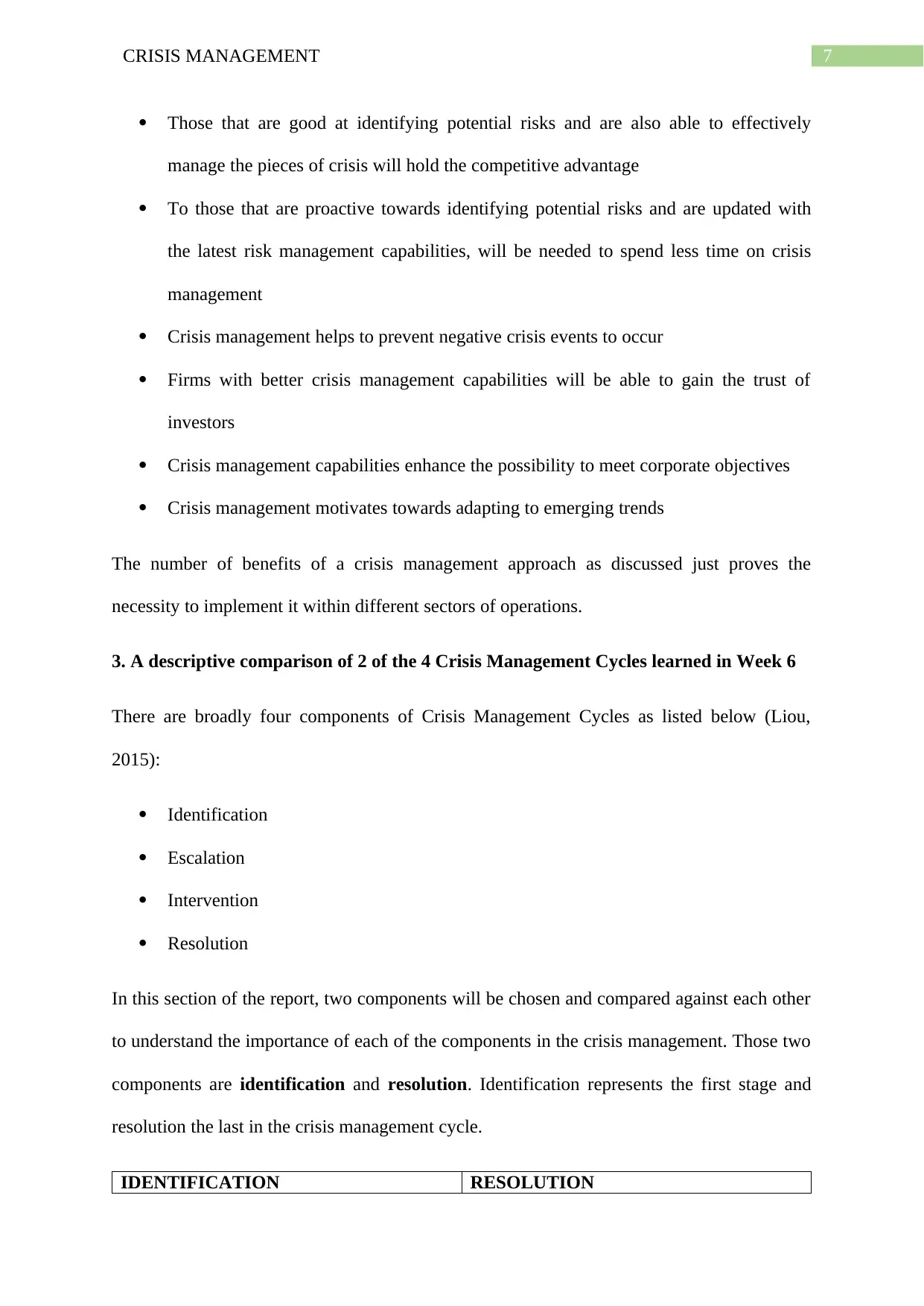
7CRISIS MANAGEMENT
Those that are good at identifying potential risks and are also able to effectively
manage the pieces of crisis will hold the competitive advantage
To those that are proactive towards identifying potential risks and are updated with
the latest risk management capabilities, will be needed to spend less time on crisis
management
Crisis management helps to prevent negative crisis events to occur
Firms with better crisis management capabilities will be able to gain the trust of
investors
Crisis management capabilities enhance the possibility to meet corporate objectives
Crisis management motivates towards adapting to emerging trends
The number of benefits of a crisis management approach as discussed just proves the
necessity to implement it within different sectors of operations.
3. A descriptive comparison of 2 of the 4 Crisis Management Cycles learned in Week 6
There are broadly four components of Crisis Management Cycles as listed below (Liou,
2015):
Identification
Escalation
Intervention
Resolution
In this section of the report, two components will be chosen and compared against each other
to understand the importance of each of the components in the crisis management. Those two
components are identification and resolution. Identification represents the first stage and
resolution the last in the crisis management cycle.
IDENTIFICATION RESOLUTION
Those that are good at identifying potential risks and are also able to effectively
manage the pieces of crisis will hold the competitive advantage
To those that are proactive towards identifying potential risks and are updated with
the latest risk management capabilities, will be needed to spend less time on crisis
management
Crisis management helps to prevent negative crisis events to occur
Firms with better crisis management capabilities will be able to gain the trust of
investors
Crisis management capabilities enhance the possibility to meet corporate objectives
Crisis management motivates towards adapting to emerging trends
The number of benefits of a crisis management approach as discussed just proves the
necessity to implement it within different sectors of operations.
3. A descriptive comparison of 2 of the 4 Crisis Management Cycles learned in Week 6
There are broadly four components of Crisis Management Cycles as listed below (Liou,
2015):
Identification
Escalation
Intervention
Resolution
In this section of the report, two components will be chosen and compared against each other
to understand the importance of each of the components in the crisis management. Those two
components are identification and resolution. Identification represents the first stage and
resolution the last in the crisis management cycle.
IDENTIFICATION RESOLUTION

8CRISIS MANAGEMENT
It is about identifying the potential
risk which could soon occur to
become a crisis
There can be multiple crisis events
in a business
Potential risks can be identified if
management has sufficient tools like
risk management framework,
conducts regular brainstorming
sessions, facilitates documentation
reviews etc.
It is technically the first stage
towards resolving or mitigating risks
Resolution can also adopt a number
of forms such as speaking on
different forms of media
Resolution can be introduced if a
business is aware of both problems
and solutions
Table 1: Comparison between Identification and Resolution
(Source: Antonacopoulou & Sheaffer, 2014)
Both identification and resolution are parts of a crisis management framework; however, both
deals with different tasks. Both are parts of a sequential approach towards mitigation of crisis.
Hence, it is important to effectively apply relevant tools specific to both terms to produce
better outcomes. Identification of potential risks or the crisis event is the first step towards
resolving the issue. Until and unless crisis events are not known, decision-making under
crisis conditions will certainly hamper. Hence, this will eventually affect the resolution stage
of the crisis management framework. Crisis-related to any business division such as
operations, financial, etc. need to be identified to know the nature of risks and severity of
escalations from various media resources to effectively analyze the level of intervention it
demands. The level of intervention will communicate the kind of resolution that a specific
crisis requires to be dealt with. A resolution, on the other hand, is technically the start of a
It is about identifying the potential
risk which could soon occur to
become a crisis
There can be multiple crisis events
in a business
Potential risks can be identified if
management has sufficient tools like
risk management framework,
conducts regular brainstorming
sessions, facilitates documentation
reviews etc.
It is technically the first stage
towards resolving or mitigating risks
Resolution can also adopt a number
of forms such as speaking on
different forms of media
Resolution can be introduced if a
business is aware of both problems
and solutions
Table 1: Comparison between Identification and Resolution
(Source: Antonacopoulou & Sheaffer, 2014)
Both identification and resolution are parts of a crisis management framework; however, both
deals with different tasks. Both are parts of a sequential approach towards mitigation of crisis.
Hence, it is important to effectively apply relevant tools specific to both terms to produce
better outcomes. Identification of potential risks or the crisis event is the first step towards
resolving the issue. Until and unless crisis events are not known, decision-making under
crisis conditions will certainly hamper. Hence, this will eventually affect the resolution stage
of the crisis management framework. Crisis-related to any business division such as
operations, financial, etc. need to be identified to know the nature of risks and severity of
escalations from various media resources to effectively analyze the level of intervention it
demands. The level of intervention will communicate the kind of resolution that a specific
crisis requires to be dealt with. A resolution, on the other hand, is technically the start of a
⊘ This is a preview!⊘
Do you want full access?
Subscribe today to unlock all pages.

Trusted by 1+ million students worldwide
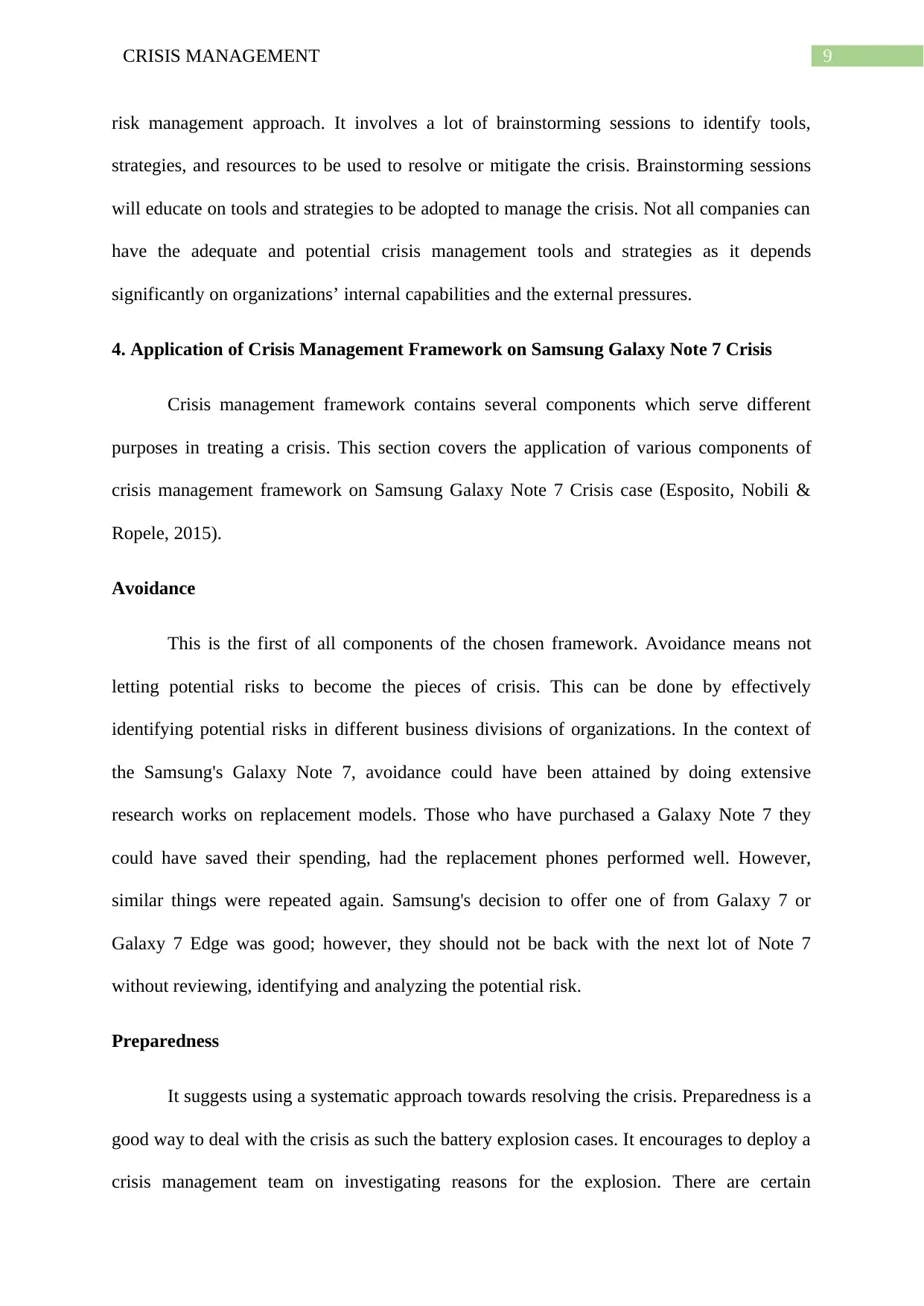
9CRISIS MANAGEMENT
risk management approach. It involves a lot of brainstorming sessions to identify tools,
strategies, and resources to be used to resolve or mitigate the crisis. Brainstorming sessions
will educate on tools and strategies to be adopted to manage the crisis. Not all companies can
have the adequate and potential crisis management tools and strategies as it depends
significantly on organizations’ internal capabilities and the external pressures.
4. Application of Crisis Management Framework on Samsung Galaxy Note 7 Crisis
Crisis management framework contains several components which serve different
purposes in treating a crisis. This section covers the application of various components of
crisis management framework on Samsung Galaxy Note 7 Crisis case (Esposito, Nobili &
Ropele, 2015).
Avoidance
This is the first of all components of the chosen framework. Avoidance means not
letting potential risks to become the pieces of crisis. This can be done by effectively
identifying potential risks in different business divisions of organizations. In the context of
the Samsung's Galaxy Note 7, avoidance could have been attained by doing extensive
research works on replacement models. Those who have purchased a Galaxy Note 7 they
could have saved their spending, had the replacement phones performed well. However,
similar things were repeated again. Samsung's decision to offer one of from Galaxy 7 or
Galaxy 7 Edge was good; however, they should not be back with the next lot of Note 7
without reviewing, identifying and analyzing the potential risk.
Preparedness
It suggests using a systematic approach towards resolving the crisis. Preparedness is a
good way to deal with the crisis as such the battery explosion cases. It encourages to deploy a
crisis management team on investigating reasons for the explosion. There are certain
risk management approach. It involves a lot of brainstorming sessions to identify tools,
strategies, and resources to be used to resolve or mitigate the crisis. Brainstorming sessions
will educate on tools and strategies to be adopted to manage the crisis. Not all companies can
have the adequate and potential crisis management tools and strategies as it depends
significantly on organizations’ internal capabilities and the external pressures.
4. Application of Crisis Management Framework on Samsung Galaxy Note 7 Crisis
Crisis management framework contains several components which serve different
purposes in treating a crisis. This section covers the application of various components of
crisis management framework on Samsung Galaxy Note 7 Crisis case (Esposito, Nobili &
Ropele, 2015).
Avoidance
This is the first of all components of the chosen framework. Avoidance means not
letting potential risks to become the pieces of crisis. This can be done by effectively
identifying potential risks in different business divisions of organizations. In the context of
the Samsung's Galaxy Note 7, avoidance could have been attained by doing extensive
research works on replacement models. Those who have purchased a Galaxy Note 7 they
could have saved their spending, had the replacement phones performed well. However,
similar things were repeated again. Samsung's decision to offer one of from Galaxy 7 or
Galaxy 7 Edge was good; however, they should not be back with the next lot of Note 7
without reviewing, identifying and analyzing the potential risk.
Preparedness
It suggests using a systematic approach towards resolving the crisis. Preparedness is a
good way to deal with the crisis as such the battery explosion cases. It encourages to deploy a
crisis management team on investigating reasons for the explosion. There are certain
Paraphrase This Document
Need a fresh take? Get an instant paraphrase of this document with our AI Paraphraser
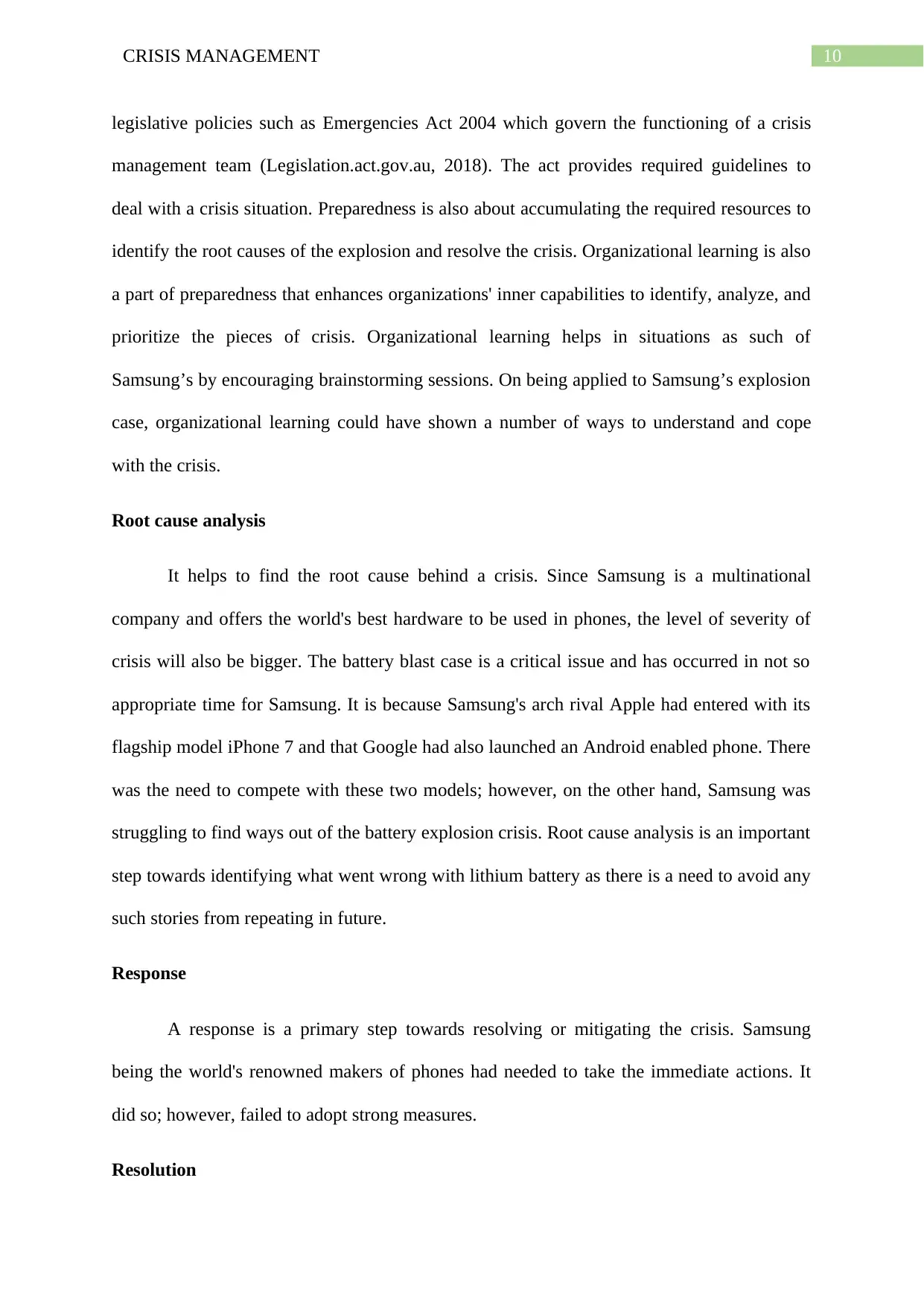
10CRISIS MANAGEMENT
legislative policies such as Emergencies Act 2004 which govern the functioning of a crisis
management team (Legislation.act.gov.au, 2018). The act provides required guidelines to
deal with a crisis situation. Preparedness is also about accumulating the required resources to
identify the root causes of the explosion and resolve the crisis. Organizational learning is also
a part of preparedness that enhances organizations' inner capabilities to identify, analyze, and
prioritize the pieces of crisis. Organizational learning helps in situations as such of
Samsung’s by encouraging brainstorming sessions. On being applied to Samsung’s explosion
case, organizational learning could have shown a number of ways to understand and cope
with the crisis.
Root cause analysis
It helps to find the root cause behind a crisis. Since Samsung is a multinational
company and offers the world's best hardware to be used in phones, the level of severity of
crisis will also be bigger. The battery blast case is a critical issue and has occurred in not so
appropriate time for Samsung. It is because Samsung's arch rival Apple had entered with its
flagship model iPhone 7 and that Google had also launched an Android enabled phone. There
was the need to compete with these two models; however, on the other hand, Samsung was
struggling to find ways out of the battery explosion crisis. Root cause analysis is an important
step towards identifying what went wrong with lithium battery as there is a need to avoid any
such stories from repeating in future.
Response
A response is a primary step towards resolving or mitigating the crisis. Samsung
being the world's renowned makers of phones had needed to take the immediate actions. It
did so; however, failed to adopt strong measures.
Resolution
legislative policies such as Emergencies Act 2004 which govern the functioning of a crisis
management team (Legislation.act.gov.au, 2018). The act provides required guidelines to
deal with a crisis situation. Preparedness is also about accumulating the required resources to
identify the root causes of the explosion and resolve the crisis. Organizational learning is also
a part of preparedness that enhances organizations' inner capabilities to identify, analyze, and
prioritize the pieces of crisis. Organizational learning helps in situations as such of
Samsung’s by encouraging brainstorming sessions. On being applied to Samsung’s explosion
case, organizational learning could have shown a number of ways to understand and cope
with the crisis.
Root cause analysis
It helps to find the root cause behind a crisis. Since Samsung is a multinational
company and offers the world's best hardware to be used in phones, the level of severity of
crisis will also be bigger. The battery blast case is a critical issue and has occurred in not so
appropriate time for Samsung. It is because Samsung's arch rival Apple had entered with its
flagship model iPhone 7 and that Google had also launched an Android enabled phone. There
was the need to compete with these two models; however, on the other hand, Samsung was
struggling to find ways out of the battery explosion crisis. Root cause analysis is an important
step towards identifying what went wrong with lithium battery as there is a need to avoid any
such stories from repeating in future.
Response
A response is a primary step towards resolving or mitigating the crisis. Samsung
being the world's renowned makers of phones had needed to take the immediate actions. It
did so; however, failed to adopt strong measures.
Resolution
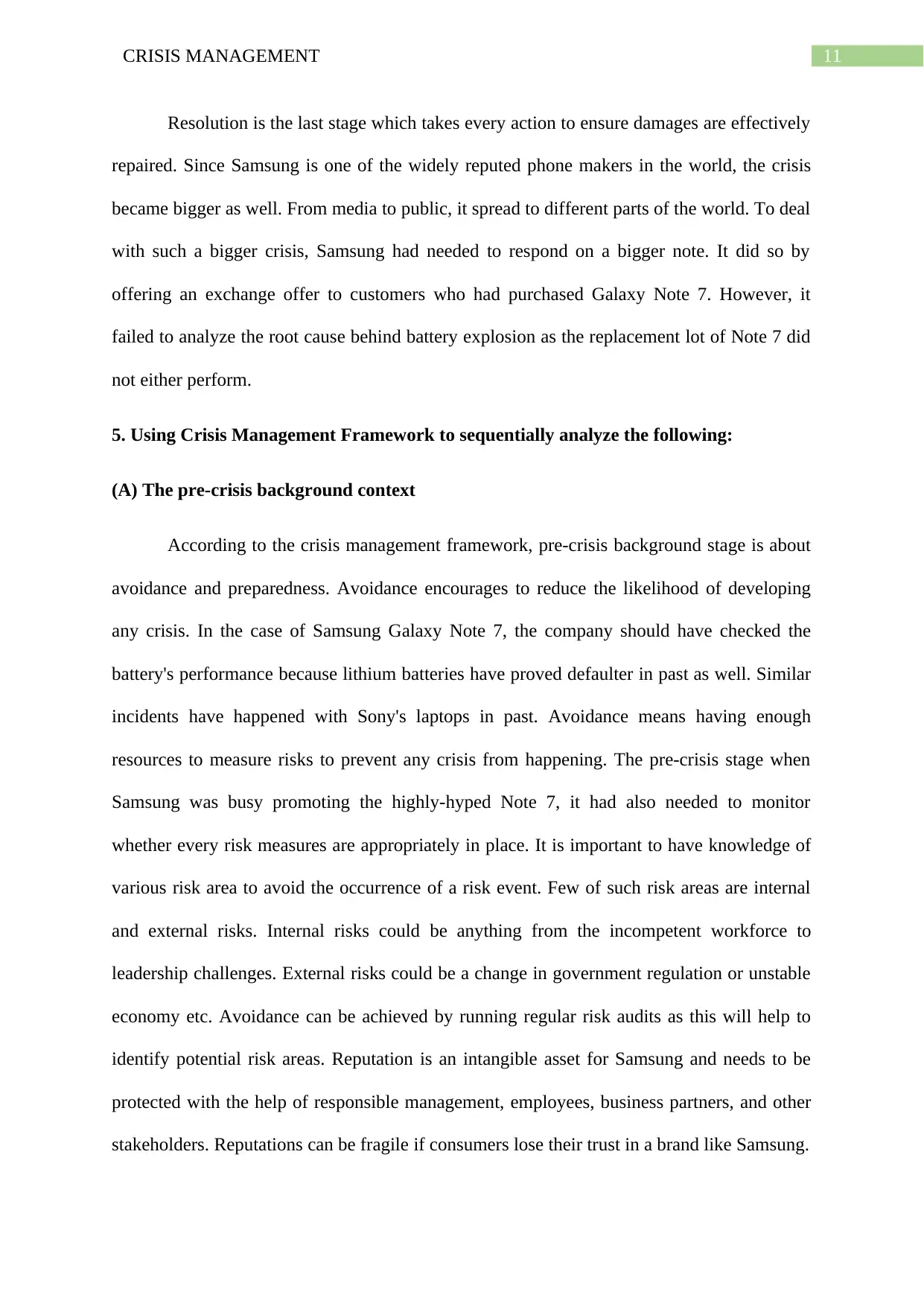
11CRISIS MANAGEMENT
Resolution is the last stage which takes every action to ensure damages are effectively
repaired. Since Samsung is one of the widely reputed phone makers in the world, the crisis
became bigger as well. From media to public, it spread to different parts of the world. To deal
with such a bigger crisis, Samsung had needed to respond on a bigger note. It did so by
offering an exchange offer to customers who had purchased Galaxy Note 7. However, it
failed to analyze the root cause behind battery explosion as the replacement lot of Note 7 did
not either perform.
5. Using Crisis Management Framework to sequentially analyze the following:
(A) The pre-crisis background context
According to the crisis management framework, pre-crisis background stage is about
avoidance and preparedness. Avoidance encourages to reduce the likelihood of developing
any crisis. In the case of Samsung Galaxy Note 7, the company should have checked the
battery's performance because lithium batteries have proved defaulter in past as well. Similar
incidents have happened with Sony's laptops in past. Avoidance means having enough
resources to measure risks to prevent any crisis from happening. The pre-crisis stage when
Samsung was busy promoting the highly-hyped Note 7, it had also needed to monitor
whether every risk measures are appropriately in place. It is important to have knowledge of
various risk area to avoid the occurrence of a risk event. Few of such risk areas are internal
and external risks. Internal risks could be anything from the incompetent workforce to
leadership challenges. External risks could be a change in government regulation or unstable
economy etc. Avoidance can be achieved by running regular risk audits as this will help to
identify potential risk areas. Reputation is an intangible asset for Samsung and needs to be
protected with the help of responsible management, employees, business partners, and other
stakeholders. Reputations can be fragile if consumers lose their trust in a brand like Samsung.
Resolution is the last stage which takes every action to ensure damages are effectively
repaired. Since Samsung is one of the widely reputed phone makers in the world, the crisis
became bigger as well. From media to public, it spread to different parts of the world. To deal
with such a bigger crisis, Samsung had needed to respond on a bigger note. It did so by
offering an exchange offer to customers who had purchased Galaxy Note 7. However, it
failed to analyze the root cause behind battery explosion as the replacement lot of Note 7 did
not either perform.
5. Using Crisis Management Framework to sequentially analyze the following:
(A) The pre-crisis background context
According to the crisis management framework, pre-crisis background stage is about
avoidance and preparedness. Avoidance encourages to reduce the likelihood of developing
any crisis. In the case of Samsung Galaxy Note 7, the company should have checked the
battery's performance because lithium batteries have proved defaulter in past as well. Similar
incidents have happened with Sony's laptops in past. Avoidance means having enough
resources to measure risks to prevent any crisis from happening. The pre-crisis stage when
Samsung was busy promoting the highly-hyped Note 7, it had also needed to monitor
whether every risk measures are appropriately in place. It is important to have knowledge of
various risk area to avoid the occurrence of a risk event. Few of such risk areas are internal
and external risks. Internal risks could be anything from the incompetent workforce to
leadership challenges. External risks could be a change in government regulation or unstable
economy etc. Avoidance can be achieved by running regular risk audits as this will help to
identify potential risk areas. Reputation is an intangible asset for Samsung and needs to be
protected with the help of responsible management, employees, business partners, and other
stakeholders. Reputations can be fragile if consumers lose their trust in a brand like Samsung.
⊘ This is a preview!⊘
Do you want full access?
Subscribe today to unlock all pages.

Trusted by 1+ million students worldwide
1 out of 19
Related Documents
Your All-in-One AI-Powered Toolkit for Academic Success.
+13062052269
info@desklib.com
Available 24*7 on WhatsApp / Email
![[object Object]](/_next/static/media/star-bottom.7253800d.svg)
Unlock your academic potential
Copyright © 2020–2025 A2Z Services. All Rights Reserved. Developed and managed by ZUCOL.





